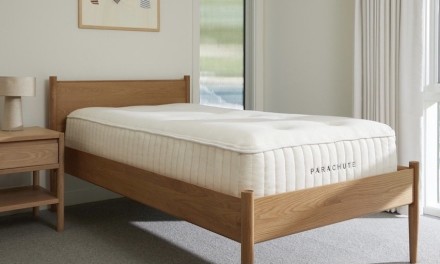A good night’s sleep starts with a quality set of bedsheets. They protect your mattress and pillows and deliver not just a sense of comfort and coziness throughout the night, but also contribute to the stylish ambiance and decor of your bedroom. Not all bedsheets are created equal, though. Selecting the right style depends on a lot of factors — the material they are made of, your personal sleeping preferences and habits and of course, the look you’re going for.
Also, consider the climate where you live. Colder destinations call for bed sheets that deliver an extra layer of warmth. At the same time, if you reside in a warmer part of the country, you will feel more comfortable dozing off in cooling bed sheets.
There are several types of bed sheets that you’ll need in your linen closet to make the perfect bed. A flat or a fitted sheet goes directly over your mattress. A duvet cover will ensure your comforter or blanket remains clean and will offer some extra softness. You can also opt for a top sheet between you and your blanket for some added comfort and warmth. A top sheet is also useful during the warmer months if you prefer to sleep without a blanket.
The Best Materials for Bed Sheets
Fabric is the most important characteristic of bed sheets because it will define the look and feel of your bedding.
The Best Materials for Bed Sheets
Fabric is the most important characteristic of bed sheets because it will define the look and feel of your bedding.
Linen
Linen
Linen is one of the most popular bed sheet fabrics, and for a good reason. Similar to cotton, it is a natural fiber made from flax plants sourced from Europe. Linen bed sheets are incredibly strong and airy, allowing your body to breathe and absorbing any extra perspiration. While they are the ideal year-round option, if you live in a place with a hot and humid climate or are only looking to upgrade your summer bedding, linen bed sheets are the way to go. One more benefit of linen is that it gets softer with every wash, so your bed sheets will get cozier and cozier as time goes by. Those with sensitive skin or allergies may also find that they feel best between a set of linen bed sheets.
In terms of styling, linen’s signature lived-in look makes it the perfect choice for a home decorated with casual, boho aesthetics in mind. The fabric’s effortlessly chic and easygoing look predisposes you to relax, making you feel comfortable and cozy.
For more on linen, check out our post: Why You Should be Sleeping on Linen Bedding Year Round.
Percale
Percale
Soft, breathable and luxuriously soft, percale is the fabric that checks all the boxes. Also known as long-staple Egyptian cotton because it grows along the Nile River in Egypt, percale is truly in a league of its own when it comes to its natural qualities.
Percale bed sheets are for those who tend to get hot at night as it keeps your body cool, and the fabric is exceptionally lightweight. Because of its extra-long staples, Egyptian cotton is very durable, and its texture gets better with age, delivering superior comfort night after night.
In terms of looks, Egyptian cotton is also one of the best materials for bed sheets. A set of crisp matte percale bed sheets will bring an elegant touch to your bedroom because the fabric doesn’t wrinkle as much and keeps its shape once fitted on your mattress or pillow. As a result, your bed will always have that well-made, commercial-worthy look.
Sateen
Sateen
There’s no better way to transform your bedroom into a 5-star hotel suite than a set of sateen sheets. The fabric is made from premium long-staple Egyptian cotton but what differentiates it from percale is the unique weave that gives it its signature smooth texture and silky sheen.
Sateen sheets are a wonderful option for those who live in colder climates. Because it’s a heavier fabric, it tends to retain heat better, giving you that extra cozy, warm feeling during the night. Its smooth texture drapes well and is wrinkle-resistant so you won’t need to iron your sheets to achieve an impeccable look. Another bonus is that sateen sheets don’t require any special care. You can machine wash them just like you would percale sheets.
Sateen sheets are beautiful on their own so you won’t need to style your bed with anything else. They look incredibly chic and sophisticated. Show them off as they are — no coverlet needed.
Read more about our sateen fabric in our post Why You Should Get Cozy in Sateen Bedding This Winter.
Brushed Cotton
Brushed Cotton
This velvety soft fabric truly is the gift that keeps on giving. While brushed cotton sheets are made from 100 percent cotton, they are incredibly soft — almost like flannel — thanks to a couple of additional treatments: brushing and garment washing. This results in the coziest bed sheets that will feel like you’ve slept in them forever from the very first night.
Brushed cotton sheets retain heat better than percale but are cooler than sateen. They are still incredibly breathable and airy, so they are a great year-round option for those who don’t necessarily identify as either cold or hot sleepers.
They have a timeless look that would complement well several interior decor styles, from rustic and traditional to minimalist, coastal and contemporary.
Does Thread Count Matter?
When it comes to bed sheets, one of the myths is that a higher thread count equals better quality. This is not true for several reasons.
First of all, thread count refers to the number of threads (both horizontal and vertical) per square inch of fabric. And let’s face it, there are only so many threads that you can fit in a small square of fabric. When it comes to cotton, a thread count of 400 is considered the golden standard. Anything above could mean two things: either the manufacturer has used thinner threads, which naturally results in a higher thread count — but not better quality — or has twisted two threads together before creating a multi-ply thread. That, unfortunately, also does not mean softer or stronger bed sheets.
If you’d like to read more on the topic, check out our post The Truth About Thread Count (It’s Not Important).
Does Thread Count Matter?
When it comes to bed sheets, one of the myths is that a higher thread count equals better quality. This is not true for several reasons.
First of all, thread count refers to the number of threads (both horizontal and vertical) per square inch of fabric. And let’s face it, there are only so many threads that you can fit in a small square of fabric. When it comes to cotton, a thread count of 400 is considered the golden standard. Anything above could mean two things: either the manufacturer has used thinner threads, which naturally results in a higher thread count — but not better quality — or has twisted two threads together before creating a multi-ply thread. That, unfortunately, also does not mean softer or stronger bed sheets.
If you’d like to read more on the topic, check out our post The Truth About Thread Count (It’s Not Important).
How to Care for Your Bed Sheets
In general, bed sheets are easy to care for as all of them can be machine-washed and don’t require dry cleaning or the use of any special detergents. Depending on the fabric your bed sheets are made of, you can use cold, cool or warm water and mild liquid Laundry Detergent. Avoid fabric softeners or dryer sheets.
These simple steps will prolong your bed sheets’ life and ensure that their color is as vibrant as when you first put them on your bed. It’s also important never to use any bleaching agents as they can damage the fabric. Another faux pas would be to dry your bed sheets at high heat or with a full load. (The latter will result in twisted bedding.) Most bed sheets can be ironed at low heat if needed.
How to Care for Your Bed Sheets
In general, bed sheets are easy to care for as all of them can be machine-washed and don’t require dry cleaning or the use of any special detergents. Depending on the fabric your bed sheets are made of, you can use cold, cool or warm water and mild liquid Laundry Detergent. Avoid fabric softeners or dryer sheets.
These simple steps will prolong your bed sheets’ life and ensure that their color is as vibrant as when you first put them on your bed. It’s also important never to use any bleaching agents as they can damage the fabric. Another faux pas would be to dry your bed sheets at high heat or with a full load. (The latter will result in twisted bedding.) Most bed sheets can be ironed at low heat if needed.
One of the most frequently asked questions is: how often should you wash your bed sheets? And while the answer will, to some extent, depend on a couple of factors, a good rule of thumb is to wash your bedding once a week. If you have pets at home or suffer from any skin conditions or asthma, you may want to throw your bed sheets in the washer every three or four days, or at least change them that often.
That’s why having a minimum of two clean sets of sheets per bed at any given time is the best. That way, even if you’re having a busy week and don’t have time to wash your bed sheets, there’s always a clean set you can use. Store any extra sets in a dry, cool place away from direct sunlight because too much sun exposure can cause discoloration.
How to Keep Bed Sheets Tight on a Bed
How to Keep Bed Sheets Tight on a Bed
Sleeping on a mattress with a loose bottom bed sheet can also be pretty uncomfortable during the night. The solution? First of all, make sure your sheets are the right size. If you have a king size bed, don’t opt for a California king size sheets because they will be too big and fit loosely. Also take into consideration the thickness of your mattress. Most bed sheets would fit perfectly mattresses up to 16 inches deep. Also, don’t dry your bed sheets on high heat to minimize shrinking.
Next, choose a fitted bottom bed sheet instead of a flat one. The elastic hem will ensure your bed sheets hug the mattress not only in the four corners but on the sides, too. Finally, if you are the DIY type of person, you can also use suspender clips to secure the corners of the sheet under the mattress. That’s an easy and effective way to ensure your bed sheet always fits snugly on your mattress.
If you are ready to shop for a new set of bed sheets, check out Parachute’s bedding collection that includes options in brushed cotton, sateen, percale and cotton to accommodate every type of sleeper. Our bed sheets are made in Portugal from the finest long-staple Egyptian cotton and are Oeko-Tex certified so you can rest assured that no harmful substances were ever used on them. Choose between a full set that will have all of your bedding needs covered or mix and match our sheets and pillowcases for a look that’s uniquely yours.











